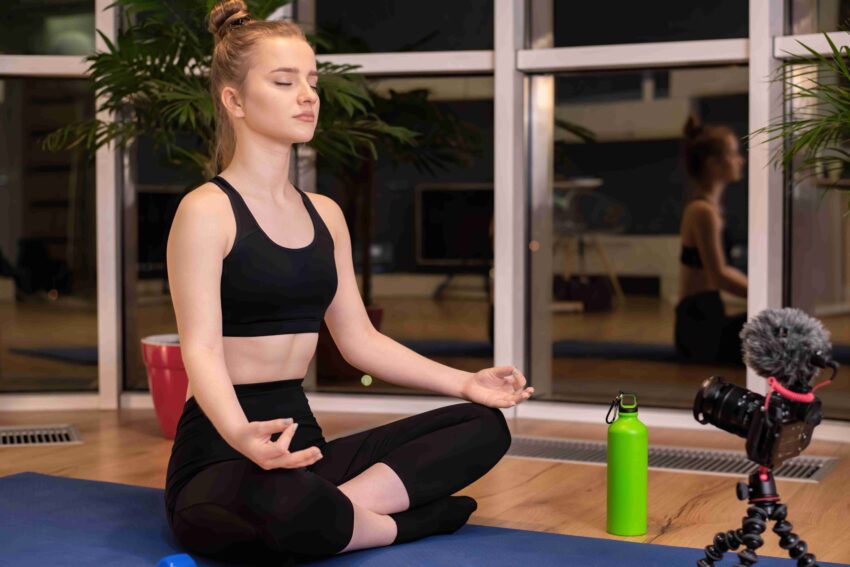YOGA FOR BEGINNERS TO GET STARTED
Yoga for Beginners is a great way to start on the path to health and relaxation. It can only do good things for anyone. Yoga for Beginners has easy poses and breathing exercises. Anyone, regardless of fitness, can do them.
Yoga for beginners increases flexibility, strength, and balance, reducing stress. Newcomers’ should try simple routines. These include a mountain pose, a child’s pose, and a downward-facing dog.
Once you start to feel a little more confident, then, by all means, go and give some different poses or routines. Remember that the goal is always to respect your limits and advance at your own pace. This contains a variety of yoga positions that are often practiced.
What is yoga?
Yoga is the old Indian system more than 5000 years ago practiced within India.
It is a skill that combines the following:
Physical postures
Breathing exercises and meditation practices.
The practice of yoga reties the severed threads of body, mind, and spirit. It created many forms and styles of yoga in the subsequent years. But the spirit of Thoreau is alive and well — though adjusted slightly to fit a modern, smart phone-cluttered life.
Yoga for Beginners Benefits
However, before I get there — why is yoga for beginners a fabulous exercise and anyone who wants to start working out full stop?
- Yoga increases your flexibility: With Yoga practice, you are stretching and lengthening the muscles in gentle ways which leads to improvements in flexibility over time.
- Builds Strength: In a little more depth, yoga for beginners uses hundreds of movements that involve different muscle groups like the legs (particularly quadriceps), arms, back, and abdominals.
- Yoga boosts your concentration by reducing stress and keeping you mentally clear.
- Improved Circulation: The stretching and movement in yoga for beginners help move the blood throughout your body, thus providing more oxygen to your muscles and organs.
- Better Posture: Because yoga helps to cultivate body awareness, you become more aware of your posture and habits in everyday life.
How to Start Yoga for Beginners
For starters, it is very important to have a lot of patience and the ability for an open approach towards yoga. Yoga for beginners is about progress, not perfection, and listening to your body on what works best for you here are a few tips to get your first customer:
Ease your way in Begin with 15-20 minutes of practice, and build up to whatever feels right for you.
Breathing: This is crucial as you yoga your way. Remember to breathe DEEP when going through the poses—Inhale and REALLY EXHALE.
Pay attention to your body: if a pose hurts or feels uncomfortable, modify it by bringing the intensity down in some way —or just don’t do that exercise. Eventually, you will build enough flexibility and strength to move on to more challenging poses.
Do you need props? Blocks, straps (yoga belt, etc), and blankets are an excellent way to modify your alignment in the poses or make them more accessible.
Check out 10 Essential Poses of Yoga for Beginners
With a basic idea of what yoga is now out there (our other article begs sharing or referring to) here are ten underlying beginner poses suitable for anybody just looking give it an initial shot.
-
Mountain Pose:
The mountain pose is the base of every yoga standing position. Improved posture, better balance, and clearer focus.
How to do it:
- Feet together; stand tall with your arms on the sides
- Evenly weigh your feet.
- Breathe in to reach up, and expand through the chest.
- Raise your hands over your head; turn palms to face each other.
- Hold for 5-10 breaths.
-
Downward-Facing Dog: Yoga for Beginners
This is a basic yoga pose that stretches the whole body, gives strength to your arms and legs as well supports in minimizing blood circulation.
How to do it:
- Start in a tabletop position on your hands with your knees underneath you and wrists lined up under the shoulders.
- Spread out your palms so that they grip the mat.
- Bend your knees slightly, tuck in those toes, and come on back into down dog- as close to an inverted V as you can!
- Modification: If your hamstrings are not flexible, lightly bend the knees.
- Hold for 5-7 breaths.
-
Child’s Pose
BENEFITS OF CHILD’S POSE This is a restful pose that stretches the back, hips, and thighs.
How to do it:
- Seated on the bottom with big toes touching and knees wide.
- Resting back on your heels reach out in front of your hands to the mat or floor stretch forward and lay forehead down into the mat.
- Take some deep breaths here, close your eyes, and melt into the pose.
- Child’s Pose x 5–10 breaths
-
Warrior I Pose: Yoga for Beginners
Balancing ones like Warrior I, which focused on strengthening the legs and opening up those hip flexors.
How to do it:
- Start in Mountain Pose.
- Take a step back with your left foot and keep your right foot forward.
- Your right knee should be over the ankle.
- Open the left foot wider and push down towards its outer edge.
- Hands OUT and Up Over your head.
- Exhale at the furthest stretch and then swap sides… hold for 5 –7 breaths.
-
Warrior II Pose: Yoga for Beginners
Warrior II — Builds strength and steadiness in the legs, opens up hips and encourages focus.
How to do it:
- Warrior II — twist the hips into the side, arms reach out & parallel to floor w/palms down
- Lock anchors the front knee and keep your gaze over to that same hand.
- 5 to 7 breaths per movement and then switch legs.
-
Tree Pose: Yoga for Beginners
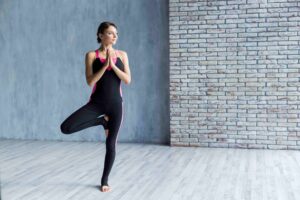
The Tree Pose: A Balance Pose that helps you Improve your level of Concentration, Stability, and Leg Strength.
How to do it:
- Start in Mountain Pose.
- Transfer weight to the left leg and bring your right foot sole against the inner side of the left thigh or calf, as high up along that area as you can without placing it directly at the knee.
- Hands to your heart center or arms reaching up.
- Reversible Side Plank Pose–5 to ten breaths on each side
-
Cat-Cow Pose: Yoga for Beginners
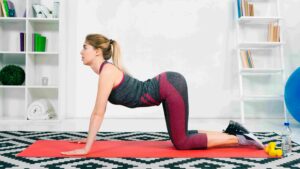
But first, you should work on the movement you can check out an exercise I love to do after sitting all day here for exploration of flexion and extension in your lumbar spine.
This is what your flexibility in round-back and arch-backed positions looks like. Cat-cow sifting just focuses the sensation on that area as you or others get into either position.
Cat-Cow Pose This stretch is a flow and movement of the spine to relieve tension, and stiffness, and increase mobility.
How to do it:
- Start on the tabletop with your wrists under your shoulders and knees underneath your hips.
- Cow Pose Inhale arch your back (Cat-Cow Flow)
- Exhale, Round your spine (cat pose); tuck chin and tailbone
- Move between Cow and Cat for 5-10 breaths.
-
Seated Forward Bend: Yoga for Beginners
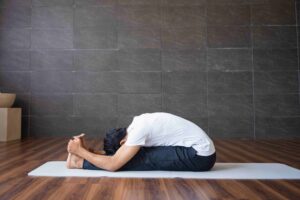
Stretches the hamstring, lower back, and spine to relax it.
How to do it:
- Lying on the floor with your legs straight (like it is bad!)
- Inhale, look up and reach over your head.
- Exhale behind your hips, and jump forward to place the feet.
- Hold for 5 to 10 breaths, breathing deeper and sinking further into the stretch with every exhale.
-
Bridge Pose: Yoga for beginners
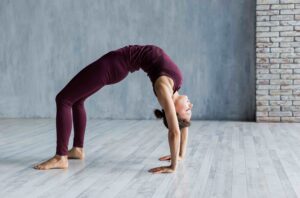
Bridge Pose This is a backbend that also stretches the chest and shoulders slightly.
How to do it:
- You will need to get down onto the floor, lie flat on your back with both knees bent, and leave a space between them that is about as wide as your hip.
- Flat arms at sides, with palms facing down.
- Exhale, pressing into your feet lift hips to ceiling.
- Interconnect your hands beneath the back, and slide your shoulders under.
- Stay for 5 to 10 breaths, and then release your hips.
-
Corpse Pose: Yoga for beginners
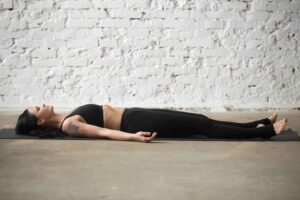
The Yoga Pose for Fatigue is the last resting posture in the yoga for beginners program and allows you to fully relax enabling relaxation processes deep into your body.
How to do it:
- Lying flat on your back with legs straight, arms relaxed at each side and palms facing upward.
- Close your eyes and just breathe normally.
- 5-10 minutes to open up the entire body.
Conclusion:
To me, that is true yoga for beginners a personal journey of self-exploration and growth. The beginner part is an extensive discussion but when it comes to them, the only thing that matters here is practice all day every day with patience and consistency.
Practice everything every single day right from your heart. So first 10 Postures to kick off your Yoga practice. Physical, mental, and spiritual benefits are all a part of them.
Remember you do not have to be in the pose it is about how we can use our body and breath. In learning to do so, you become more flexible and strengthened in both body and spirit the longer you practice.

